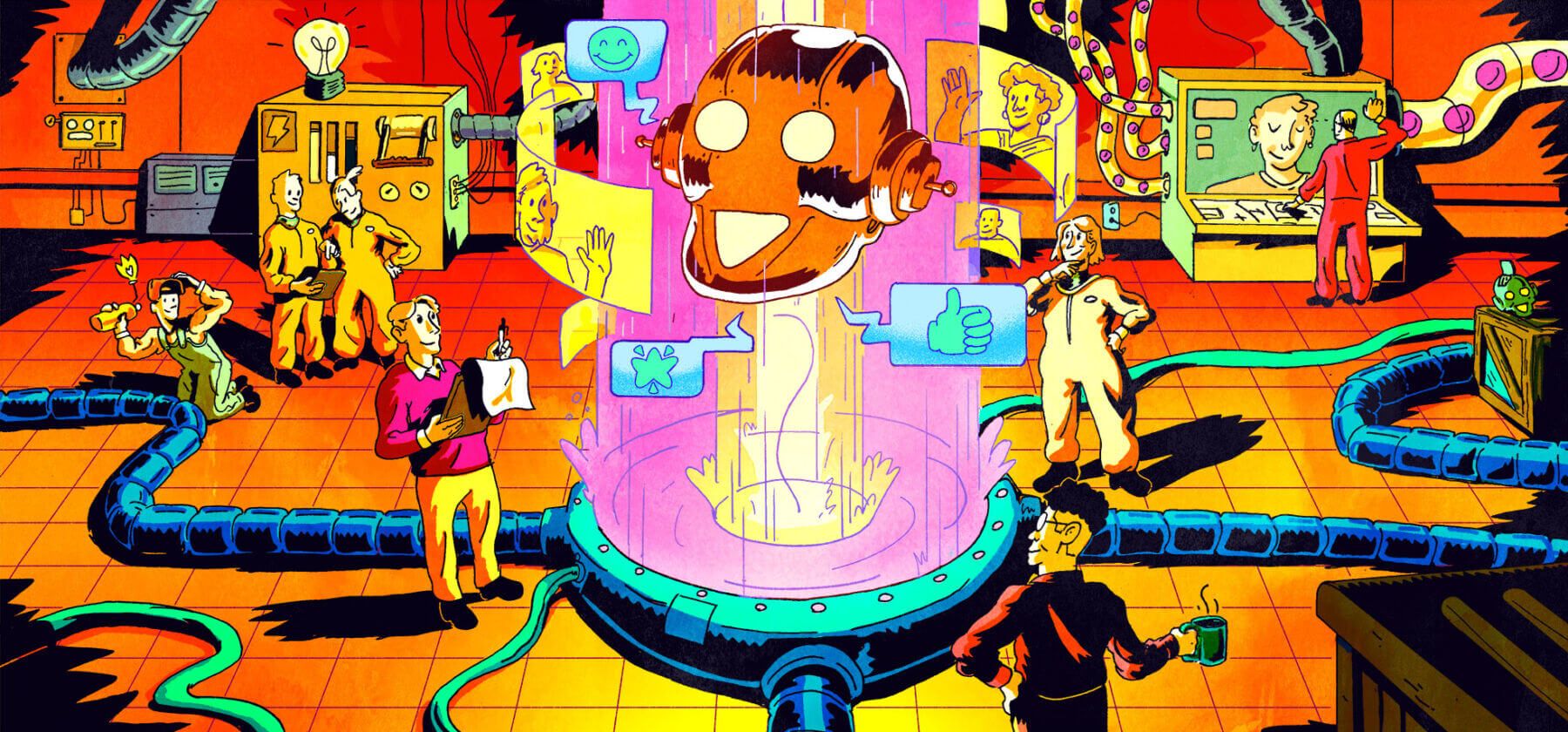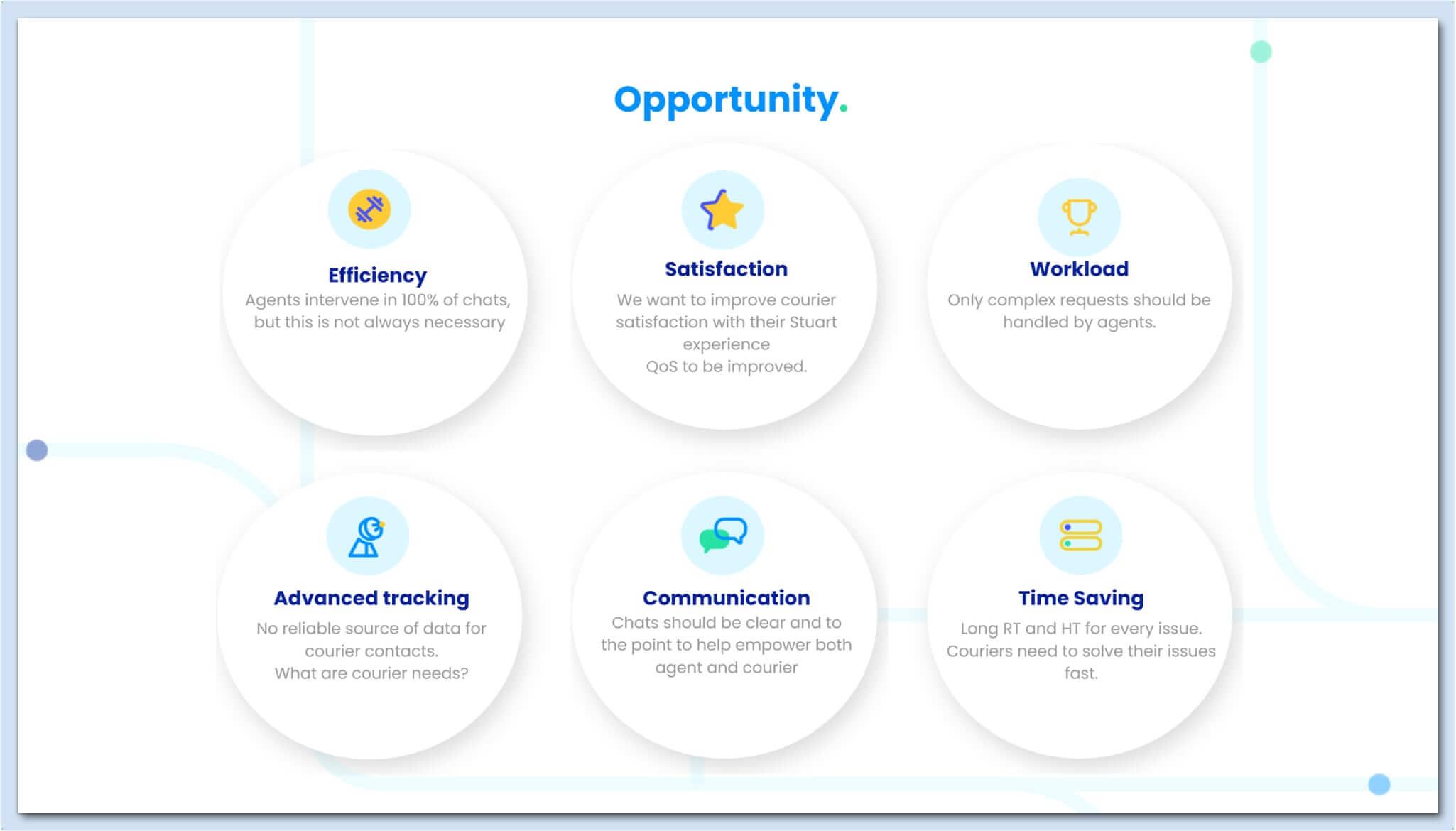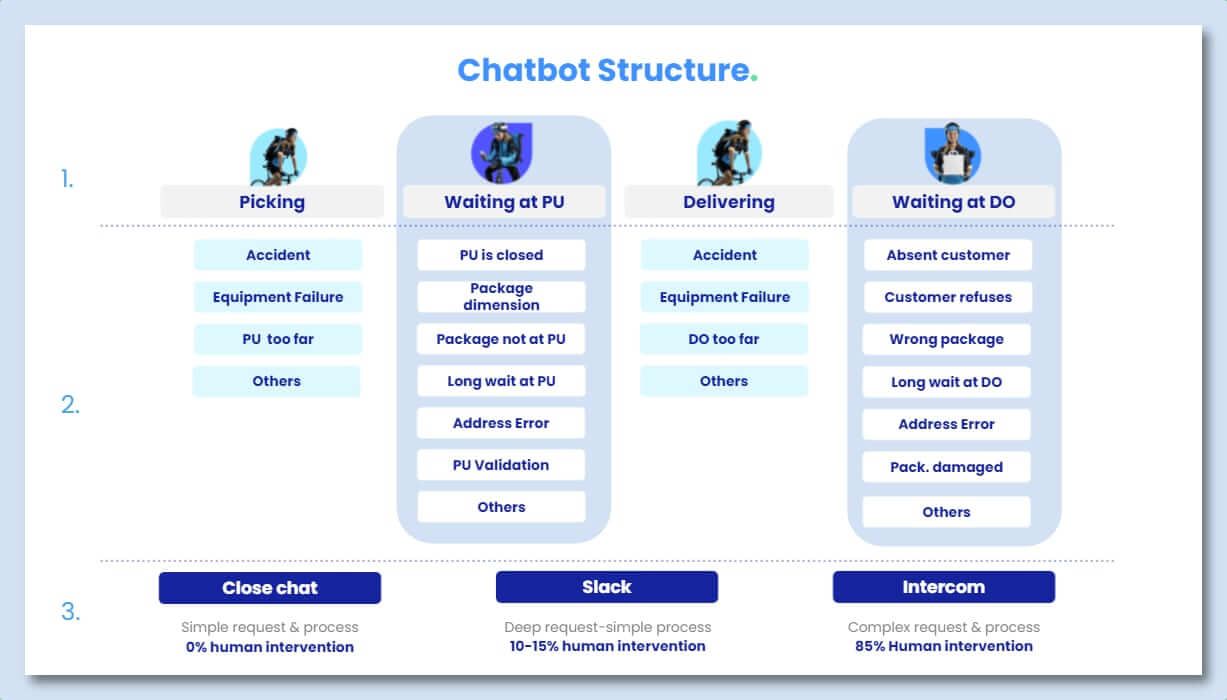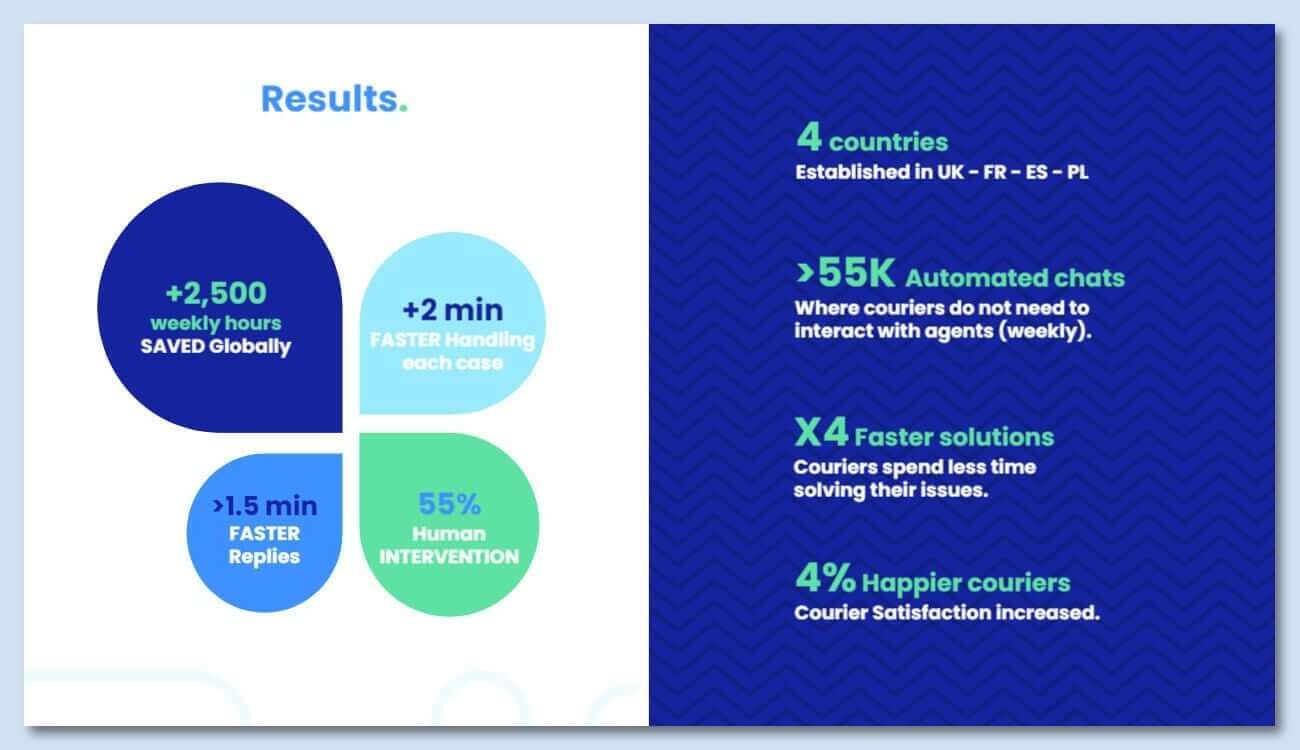
Building bots for success: The custom bot that saved logistics platform Stuart over 2.5k hours per week
Main illustration: Connor Robinson
It’s more evident than ever that the key to strong, scalable customer support that both delights your customers and moves the needle for your business boils down to one thing: creating a support experience that strikes the right balance between being personal and efficient.
If your support team is answering question after question as they roll in, scaling your support and driving bottom-line business impact will be a challenge. On the other hand, overloading your support with automation and leaving customers in a never-ending loop trying to get in touch with your team is inevitably going to result in an impersonal and frustrating experience. Conversational support provides a solution to these challenges, combining elements of automation and technology and the knowledge and expertise of your team to power your support at scale – without losing the personal touch your customers know and love.
“Today, Intercom’s Custom Bots are saving Stuart over 2,500 support team hours and automatically resolving 55,000 chats every week. They’ve also enabled the team to reduce their response time to less than 30 seconds, reach resolutions 4x faster, and more.”
Owned by GeoPost, leading logistics platform Stuart uses Intercom’s Conversational Support solution to strike the perfect balance between providing personalized and efficient support and driving value across the business. With bots and automation resolving simple queries and triaging inbound conversations behind the scenes, Stuart’s support team can be empowered to spend more time resolving issues – and less time performing manual tasks that can quickly become a time sink. Today, Intercom’s Custom Bots are saving Stuart over 2,500 support team hours and automatically resolving 55,000 chats every week. They’ve also enabled the team to reduce their response time to less than 30 seconds, reach resolutions 4x faster, and more. Here’s the strategy the team used to drive business impact and position support as a key value driver.
Identifying opportunities for growth
Stuart’s Head of LiveOps and Support Andrew Baylis and Program Manager Marina Alejo are focused on driving increased efficiency in the support org and creating personalized support experiences to ensure that their clients’ and delivery partners’ needs are being met. Having long leveraged self-serve support capabilities in Intercom to maintain a high level of efficiency, Andrew and Marina decided to take a closer look at where there could be opportunities for additional growth across their delivery partner support journey.
“It’s important that we’re able to resolve our delivery partners’ issues quickly and that we can offer them self-serve support so they can focus on their job and feel supported”
“We wanted to offer the best service to our delivery partners while also reducing the workload for our customer support team,” says Marina. “It’s important that we’re able to resolve our delivery partners’ issues quickly and that we can offer them self-serve support so they can focus on their job and feel supported. For our support agents, we want them to have enough time to deal with complex requests and be empowered to provide a better quality of service and experience to our delivery partners.”

Driving efficiency through automation
Following Andrew and Marina’s analysis of their existing support journey and opportunities for improvement, they made the decision to roll out a new chatbot strategy and leverage Intercom’s Custom Bots to create a dedicated “courier bot”. The primary goal of this bot, Marina explains, was to introduce a level of automation into the delivery partner support journey in order to make it a more seamless experience for both the delivery partners and the team.
Prior to the rollout, Marina notes that there was a very high level of manual intervention needed to resolve queries that were coming in from their delivery partners. “When delivery partners contacted us before we introduced courier bot, they were writing to the team through the Intercom Messenger and chatting directly to an agent who would have to investigate the query in our back-office platform, potentially contact the client and end customer, and liaise back and forth until the query was resolved,” she says. “It wasn’t an efficient use of time for anyone.”
With the introduction of the new courier bot, the team had two main objectives in mind:
- Make the delivery partner support journey more efficient and seamless, as well as reduce the workload for the support agents.
- Unlock further growth potential to scale Stuart’s support across all of their markets and support more delivery partners without increasing headcount on the support team.
Strong, scalable support
When mapping out their plan to improve the delivery partner support journey and power faster resolutions at scale, Andrew and Marina saw opportunities to drive impact and create value in a number of key areas.

- Support efficiency
The team’s analysis highlighted that human intervention in all inbound conversations was an inefficient way of working. Introducing courier bot would enable the team to massively reduce this workload while still scaling their support to help more delivery partners and reach faster resolutions. - Delivery partner satisfaction
Having sought feedback from their delivery partners, it emerged that fast response time was a top priority when seeking support. In an effort to boost and maintain a high level of delivery partner satisfaction across all of their markets, the team looked to make their support process more streamlined to ensure their delivery partners’ needs were being met. - Support workload
Knowing that the one-agent-to-one-delivery-partner ratio wasn’t a scalable model, the team saw huge opportunity for growth with the introduction of courier bot. With the bot resolving frequently-asked and easy-to-answer questions automatically, the support team’s workload could be reduced significantly, resulting in time – and money – saved. - Identifying conversation trends
Without bots and automation, it can be difficult to consistently tag, log, categorize, and analyze trends in the queries your team is receiving. With courier bot, Marina explains, the team would have a single source of truth for delivery partner conversation trends – and even forecast issues based on the trends they were seeing to get ahead of problems before they arose and offer proactive support. - Enabling seamless communication
Of the feedback collected from delivery partners, another priority that emerged was clear communication. Courier bot would enable the team to clearly outline options for getting support and make the journey easy to navigate. It would also collect valuable information from delivery partners upfront so agents could more seamlessly communicate with delivery partners and resolve the issue when additional support was needed. - Saving valuable time
With agents manually handling every inbound conversation, response and handling times can get long – fast. Courier bot could help to reduce these times significantly by empowering their delivery partners to self-serve and find answers to their own questions, set clear expectations around wait times to speak to the team for more complex issues, and do the work of collecting context for the team so a resolution can be reached faster.
Implementing the solution
Having identified how courier bot would benefit Stuart’s support in each of the key areas identified, the team decided to roll it out across the four pillars of their delivery partner support journey. This journey is broken down into groups of the most commonly received queries and the stage of the delivery process that they map to: picking up a delivery, waiting at the pick-up point, making the delivery, and waiting at the drop-off point.

With the introduction of the bot, delivery partners can now be routed to the right place to find an answer to their query, specific to the stage of the delivery process they’re currently at. If the bot can resolve the issue, it will automatically close the conversation, but if the delivery partner needs additional help, the bot can route their query to the Stuart team. The queries are then either directed to Intercom where a new conversation is opened, or to Slack, which is integrated with Intercom to enable notifications to be sent to the support team. Since its implementation, the courier bot has helped to save a whopping 2,500 support team hours per week.

Driving value across the business
In addition to the staggering amount of time saved per week, the team at Stuart has seen incredible results across the board in their response and resolution times, delivery partner satisfaction, and more.
- Agent response times have been reduced to < 30 seconds, with the bot offering instant responses to delivery partners who wish to self-serve.
- More than 55,000 chats per week are being automatically resolved by the bot.
- Resolutions are being reached 4x faster.
- Human intervention has been reduced to 55%.
- Handling time for each case is now two minutes faster.
- Delivery partner satisfaction has increased by 4%.

Looking to the future
Looking ahead, the team at Stuart has plans to continue to find opportunities to scale, empower their support agents to quickly resolve issues, build relationships with their clients and delivery partners, and ultimately, provide them with a support experience that builds customer loyalty and advocacy. The long-term vision, Marina explains, is to even further evolve their use of self-serve support, which is something that their delivery partners often avail of in order to find answers to their own questions in a quick and easy way. Doing this will help to set the team up for success and enable them to continue creating support experiences that are both efficient and personal.
“We see a lot of benefits to be gained in empowering our delivery partners to self-serve”
The benefits, she says, will be abundant, pointing to both the internal and external advantages of leveraging automation and self-serve support in this way. “We see a lot of benefits to be gained in empowering our delivery partners to self-serve,” she says. “Not only will we have increased visibility on our end of incoming queries and trends, we can also forecast problems, enhance our ability to offer proactive support – and, of course, continue to drive efficiency.”








